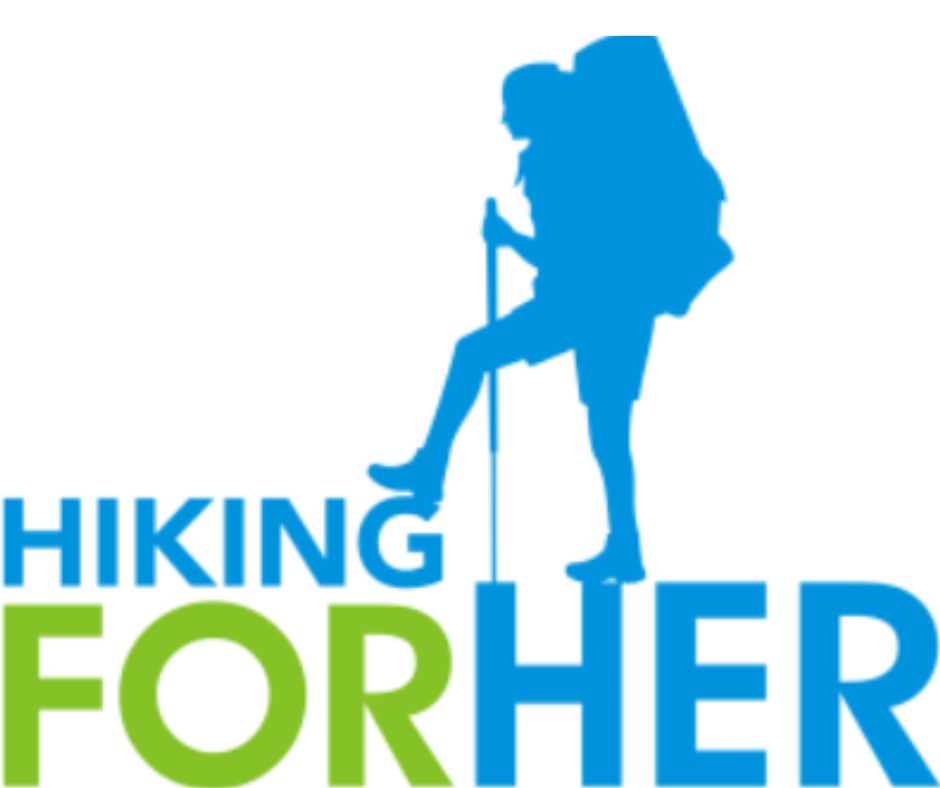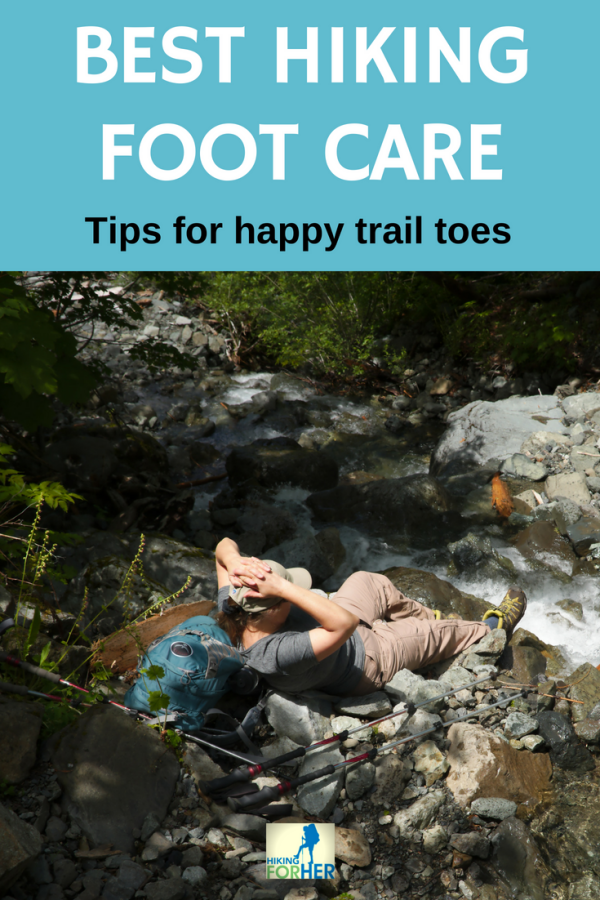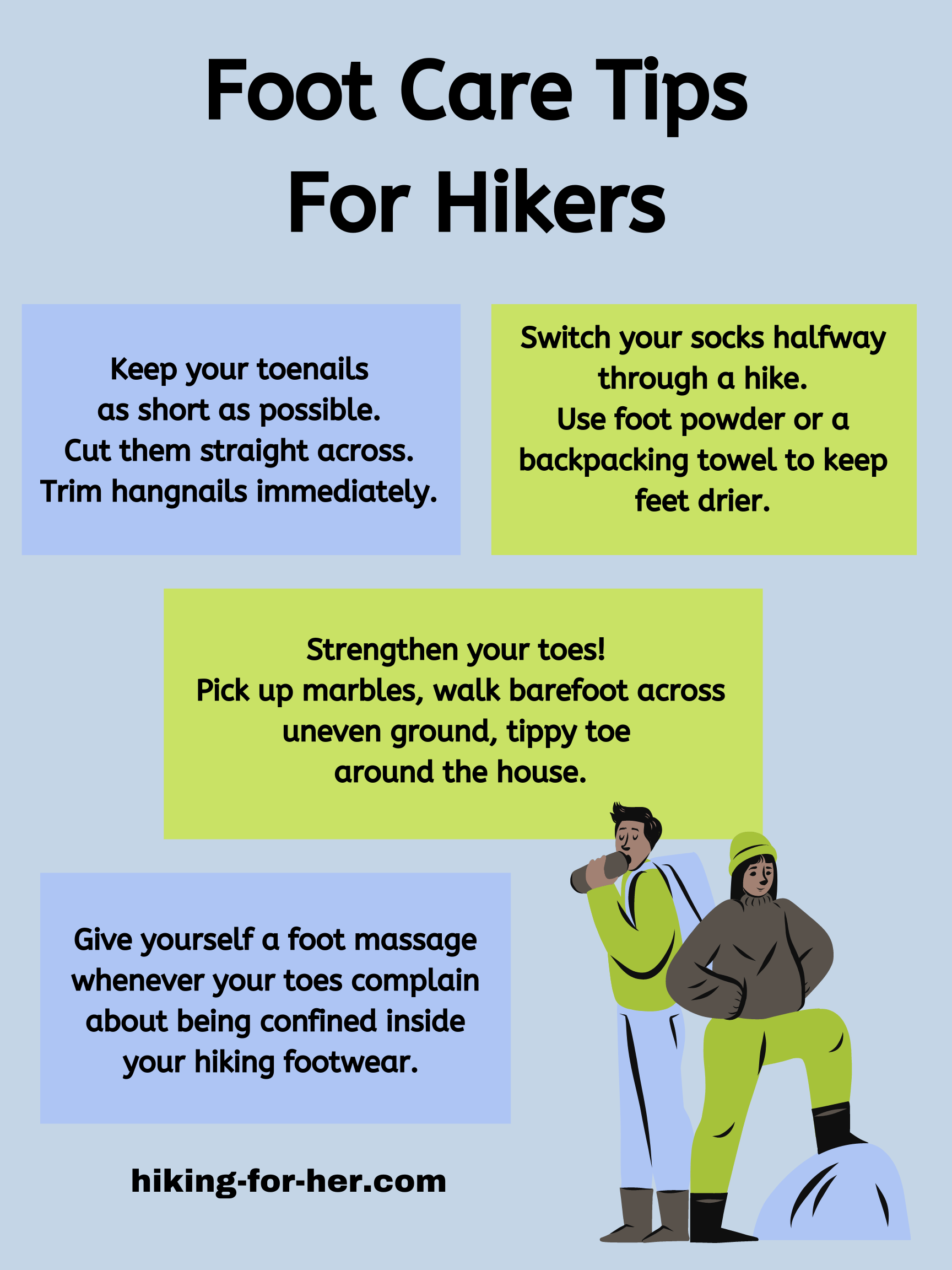Hiking Foot Care:
Best Tips To Keep You
On Your Happy Trail Toes
By Diane Spicer
Quick!
What's the first thing that comes to mind when you think of hiking foot care?
If it's sore, troubled feet, you're in the right place!
You really need these best hiking foot care tips :)
Hiking foot care -
let's keep it simple
It's astonishing how abusive hikers can be to their precious feet.
In fact, some hikers brag brazenly about the number and depth of blisters they accumulate on a backpacking trip! (and yes, there are Instagram photos)
There seems to be a perverse competition around how many toenails fell off during a backpacking trip (again with the nasty pictures).
Just between you and me, I wonder if these hikers take a ball-peen hammer to their car when they're on a road trip?
- Because that's pretty much what they're doing to their only mode of transportation when they let foot problems develop on a hike!
Maybe foot abusers think
hiking foot care is complicated?
It's not!
Just 3 big categories of foot care action tips, which you can skip down to right now if you'd like:
Note that some of these are affiliate links, meaning HFH will receive a small amount of your purchase price but you don't pay extra.
Some of these products will be reviewed, and featured as giveaways, right here on this website.
- So be sure to sign up for the monthly newsletter (see box at top of page) so you don't miss anything.
And none of this information is meant as medical advice.
When in doubt, consult your medical care providers for advice and treatment.
Foot care strategies:
preventive maintenance
When hiking foot trouble begins to brew, you can make the smart choice to do a few simple, constructive things to help yourself.
But first, let's look at foot preventive maintenance strategies to keep your precious hiking feet in top shape.
Notice
when it's not normal
I feel silly typing this sentence, but Thing One for the best advice for hiking foot care is to notice when something feels different.
- Right away, not the morning after your hike when you're in pain.
Which implies that you make regular hiking foot care a "must do" item in your weekly schedule.
This makes it extremely likely that you will see, and feel, when something isn't right on your feet during a hike.
Toenail maintenance
Long toenails bump against the toe box on your boots, leading to bruising and possible loss of the nails.
Without fail, spend a few moments on a weekly toenail trim, using a sturdy stainless steel toenail clipper.
If you're on a long backpacking trip, pack nail clippers and use them regularly.
If you share them with your trail buddies, give them a soap and water treatment between buddies (see fungal issues below).
Or use pre-moistened wipes with an alcohol base to clean them up.
Random life tip:
If you've never used Tweezerman products, you're missing something really well designed and practically painless for nail maintenance as well as unwanted facial hair removal and eyebrow maintenance.
- Which has nothing to do with our topic, but hey! a few surprises here and there on the page never hurt ;)
Message from your feet:
don't be callus
Every pair of feet belonging to a hiker has its share of calluses.
- Contact between your boots and your skin guarantees that you will build up layers and layers of dead skin as a normal response to pressure and friction.
A callus isn't necessarily a bad thing, but you may consider it unsightly.
Worse, a rough callus will snag on your socks, crack open as an entry point for microbes, or create a new hot spot on your feet if you switch your boots or trail shoes.
The standard approach to a callus is to cut or file it down.
The problem with that approach?
- In the body's wisdom, you are stimulating the cells underlying the callus to create more layers with a vengeance.
- This creates a maintenance cycle you might not want.
Here's skin exfoliation done the smart, gentle way, with no scary looking cutting or filing tools.

Heel callus maintenance calls for a different approach.
An easy-to-use callus stone (also from Tweezerman), followed by rich emollient organic shea butter, will make your feet presentable for your off trail activities.
Freedom from fungi
Here's a great way to avoid nail fungus.
Never try on used hiking boots or trail shoes without wearing your own pair of socks which fully cover your feet and ankles.
Ditto for wearing a trail buddy's boots, even for a quick trip to the creek for water during dinner prep.
- Trust this retired microbiologist: you don't want these funky fungal hitchhikers to take up residence on your feet!
Acknowledge
that your feet need your attention
Many, many times I have heard a tale of woe from a hiker with the punch line "...if only I had done something right away."
Which provides you with a secret weapon for hiking foot care:
- take time to address the problem as soon as you feel discomfort.
I beg you to ignore all urges to keep soldiering on bravely in order to accommodate a hiking schedule (oxymoron, if you ask me).
Or to prove just how tough you are to your hiking partner.
Because just in case you've never had a nasty blister or an infected toe, you won't be able to carry on for long because it's going to HURT.
- Hurt like you cannot imagine even if you try very hard!!!
So if only to keep yourself out of pain - and along with associated loss of trail time - stop when your boot starts rubbing your heel.
Or a hot spot develops on the bottom of your foot.
When you feel something poking into your sock, or there's a gritty sensation between your toes, STOP!
On the other hand, you can play the mental "what could be causing this?" game until it's too late to fix whatever it was that was causing your problem.
Your choice!
Self awareness check:
Is this advice to stop, sit down, and remove your boot or shoe too simplistic for you?
Wow. Just wow.
- These are the only feet you have to take you out there, and get you back again.
Act immediately
to address problems
This is what will separate you from the hiking rookies.
Not only will you sit down and take a good look at whatever is causing you grief inside your hiking boot.
You're carrying a few supplies (see above) that are going to make a whole lot of difference in your life.
- You shall be known as She Who Smiles And Completes The Hike, rather than The Hobbler.
These hiking foot care tips will get you all set up for success:
Foot care strategies:
proactive trail tips
You now have a baseline for what your feet look, feel and smell like, so it will be easy to spot trouble when it crops up during a hike.
You also have some hiking foot care strategies.
Just to be extra cautious to avoid the dreaded hobble back to the trail head, take these actions during a hike:
- At your lunch spot, take off your boots and air out your feet.
- On chilly or damp days, wipe them off with absorbent, reusable and ultra lightweight towels made from absorbent sponge, like these.
- Drape your socks on a nice hot rock in the sun, or over a handy branch, to allow the sweat to evaporate.
- Swap out saturated socks for a fresh pair. Tie the soggy ones to the outside of your pack to dry.
- Attend to any hot spots - areas which feel tender or warmer than the rest of your feet- with these blister avoidance strategies.
- If you are concerned about the copious amounts of sweat you produce inside your trail footwear, carry a foot cream which absorbs moisture. Bonus: it gives you a fragrant lift on your way back to the trail head.
You know that "foot break" I urged you to take during your hike?
 |
You'll look like a genius to your trail buddies, too. |
Foot care strategies:
smart gear choices
If you're new to the hiking universe, you may not have heard this little secret:
- The socks you wear must be top notch to prevent foot problems.
Yes, they are going to be a bit more pricey than your bargain bin cotton socks.
Yes, they are worth that extra coin.
Once your feet are safely encased in the best hiking socks, turn your attention to finding breathable, lightweight and durable boots or trail shoes that fit you.
Not getting the best possible fit? Try hiking insoles.
Best hiking foot care products
for pampered hiking feet
These recommended products take you beyond the weekly maintenance plan you've got going, into The Land of Blissful Rejuvenation and Pampering.
Using this approach also demonstrates common sense kindness to the bones, muscles, ligaments and vessels which take you on your hiking adventures.
Can you say ah?
 |
If you've never explored how many achy spots you have on the bottom of your feet, you're in for a big surprise. |
A device that fits into the arch of your foot, like this Gaiam wooden foot roller, will gently relieve the soreness and tender spots, while stimulating blood flow to your far flung digits.
Tip:
If you suffer from plantar fasciitis or foot cramps, this might be a sensible addition to your foot care strategy.
And this handy kit offers you relief from soreness beyond your feet.
More ahhhh!
 |
If you get into the idea of treating sore spots with pressure and massage, this mini massager works on your feet plus your hands, arms and legs. |
Small enough to bring along on your hike to address foot or toe cramps, too.
Also works great to stimulate blood flow in your feet on long plane or train rides when you travel.
Tip:
Gaiam products are top quality and in regular use at Hiking For Her, including yoga mats and blocks, making them easy to recommend to you.
Keep the rejuvenation going!
After your foot massage, rehydrate your skin with Badger tea tree and eucalyptus (renowned for anti-fungal properties) foot balm in a handy two ounce metal tin.
Saved the best hiking foot care tip for last:
the ultimate
hiking foot care idea
If you want to go all out, here's the best tip for hiking foot care I can share with you:
- After you've attended to any trouble spots, trimmed your nails, massaged and applied lotion, brew a delicious cup of herbal tea.
- Then wrap your feet in this aromatherapy heat wrap.
- filled with flaxseed to absorb heat from the microwave and gently transfer it to your feet
- lavender scented for relaxation
- large enough to use elsewhere on your sore, achy muscles, or when you want some down time with warmth and a lovely aroma surrounding you
- can also be stored in the freezer and used as a cold pack for sore feet
Be nice to your trail footwear, too
 |
Stinky feet. Stinky socks. Which means your hiking boots and trail shoes are stinky, too. Don't just endure it, fight it! Shoe Defenders will absorb moisture and odors after your hike. |
Hiking foot care
is a worthwhile investment of your time
Regular attention and maintenance for your feet will pay off on the trail, because you will know when something is not normal, and what to do about it, immediately.
You are so worth it!!
- More great foot care tips here.
Has it occurred to you that any of these hiking foot care items would make a dandy gift for a trail buddy?
Especially when they see you using them with great results on the trail.
- Or gather them together into one awesome gift basket for a birthday or special trail celebration!
Need more hiking self care tips to explore?
Just trying to stay one happy, pain free step ahead of you...
Best wishes for happy trails (and toes)!
Best Hiking Foot Care Tips
|
I get emails all the time about what I wear, eat, carry and love to use on the trail. That's
why I provide affiliate links to you: the best gear that I use myself and have seen used by other hikers is instantly
available for your consideration, and the gear company sends a few
pennies per dollar to this reader-supported hiking website. There is no added cost to you! Everyone ends up a winner: Great gear for you, strong gear companies, and more free hiking tips for everyone. Thanks very much for your support. It's warmly and sincerely appreciated. It also helps send these hiking tips to all your virtual trail buddies around the globe. |
 |








